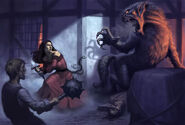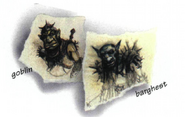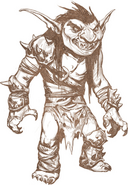Barghests (pronounced: /bɑːrˈgɛst/ bar-GEST[6] ![]() listen) were fiendish lupine shapeshifters and the only true natives of Gehenna.[3][7] They commanded goblinoids and consumed mortal souls to gain power and return to the Fourfold Furnaces.[4]
listen) were fiendish lupine shapeshifters and the only true natives of Gehenna.[3][7] They commanded goblinoids and consumed mortal souls to gain power and return to the Fourfold Furnaces.[4]
Description[]
The true form of the barghests resembled goblin–wolf hybrids with monstrous jaws and razor sharp claws.[3] They were able to shapeshift into either a goblin or canine form, each of which were indistinguishable from normal members of their kind to most.[5] Goblins immediately recognized barghests in their goblin forms and no matter the canine form they assumed, whether war dog, wild dog or wolf, other canines could easily identify them.[4] A hateful, orange glow was given off by their intelligent eyes when they were excited and they occasionally possessed unusual traits that betrayed their true nature, such as a shock of white hair or a discolored eye.[2][3]
Barghest whelps naturally appeared as larger, yellow-skinned goblins, eventually developing the ability to take on the form of a large wolf with powerful claws, their true form as this stage. As barghests matured, their forms grew to about 6 feet (1.8 meters) long, weighed 180 pounds (82 kilograms), and their yellow skin darkened to a shade of bluish-red until eventually turning entirely blue.[1][3][4] Barghests that achieved greater status could transform into 8 feet (2.4 meters) tall, 400 pounds (180 kilograms), goblin-like monsters or into dire wolves.[3] On incredibly rare occasions, barghests could grow to such gargantuan proportions that they could occupy small mountains.[9] Other goblinoid races like the bugbears or hobgoblins were known to have barghest versions of their kind.[2]
Personality[]
Barghests were treacherous tyrants that craved power over others, ruling goblinoids through fear and force.[2] During their time in the Material Plane they grew not only physically but mentally, learning the skills and strategies needed to lead and hunt in the much harsher and competitive Gehenna.[4] Bugbear barghests often attempted to incite other goblinoids into committing acts of violence against others while hobgoblin barghests commanded the terrified respect of their underlings and enemies.[2]
Abilities[]
Barghests had numerous spell-like abilities at their disposal, such as levitate, pass without trace, dimension door, charm person, and numerous illusion and enchantment powers.[1][3][4][5] Greater barghests had access to group spells such as invisibility sphere, mass bull's strength, and mass enlarge.[3]
They could take on either their true forms, goblinoid forms or canine forms in a matter of seconds although their equipment was left behind. Their goblinoid forms were generally deprived of natural weapons but could don armor and handle tools.[3] Some were also capable of taking on other humanoid shapes, such as those of drow, but would keep their bestial strength even in more lithe forms. Their wolf form was faster and stealthier than their true form and able to use past without trace much quicker, but lacked much of their spellcasting, and the claws of their true form.[3][10] Canines were immediately driven to fear and hate barghests in their wolf forms, attacking them whenever feasible.[5]
Although enchanted weapons were required to seriously harm a barghest, they possessed a number of glaring weaknesses. Holy water was a viable weapon against them and barghests that had not reached greater status could be affected by fiend-targeting powers like protection from evil or the turning powers of some clerics.[11] Ironically, the fiends were most threatened by open flames, as infernos larger than their bodies, either 10 feet tall or wide, could immediately return them to Gehenna. They could attempt to resist the draw of their home plane and normally could not be banished by explosions or bursts of fire like from the breath of a red dragon or a fireball spell.[1] When in canine form however, barghests suddenly enveloped by magical flame were just as likely to be sent back to the Fourfold Furnaces as they were under normal conditions.[5]
Combat[]
Driven by their instinctual bloodlust and primal hunger for the life essence of mortals, barghests preferred to tear into foes with their natural armaments rather than using manufactured weapons. They had a tendency to unconsciously drop such weapons on the ground but were rational enough to overpower their bestial urges if given sufficient reason. The advantage provided by enchanted weapons was often enough to compel greater barghests to use them, but barghests would also use weapons if doing so furthered a scheme somehow.[3][10]
Despite their murderous intent and savage impulses, barghests were ambush predators that rarely confronted foes under equal terms. After disguising their numbers and positions, they magically manipulated enemy emotions to disorient them. When in packs, barghests ganged up on as few opponents as possible at the same time, using their speed to avoid powerful enemies.[3][12]
Unlike the silently stalking bugbears, barghest savagers leaped boldly into battle and looked for useful targets to drain. On the other hand, hobgoblin barghests allowed enemies to come to them, waiting for as many foes to draw close as possible before absorbing the group's life force and backing away when attacked.[2]
Society[]
Barghests on the Material Plane operated either alone or with a sibling, lurking in remote humanoid communities or joining bands of goblinoids although they weren't opposed to leading other wicked races.[2][4] Normally they attempted to keep their true nature hidden for as long as possible, devouring the occasional goblin when given the opportunity until old enough to find more promising prey and too obvious remain inconspicuous. Goblins sycophantically worshiped barghests, each pathetically trying to demonstrate its worth to its host in order to avoid the ire and hunger of their new masters. Barghests typically retained their goblinoid forms when leading such tribes, existing in a strange and cruel symbiosis with their goblin host.[1][4][13] So long as the goblins could please the barghest with gifts and sacrifices the barghests would protect the tribe from threats and bolster their hoards, with bugbear barghests in particular leading murderous raids on villages.[2][4] Barghests earned greater acclaim and status in Gehenna when they consumed great goblinoid leaders and other powerful souls, making them the primary targets of their voracity.[1][4]
Barghests on Gehenna tried to isolate themselves from each other, seeking out their own reeking valley rifts to act as their strongholds and amassing their own servant collections. Unlike on the Material Plane, barghests on their native plane collected personal treasure hoards of unknown value and composition.[4] They attempted to forge small fiefdoms of slaves in order to wage war on their rivals, typically other barghests, and young barghests were sent to the Material Plane in an attempt by the elders of the race to both safely raise their children and stay in power.[14][7] If a barghest was sent back to Gehenna before eating enough souls to return on its own they were likely to be killed or enslaved, whether by a yugoloth or its kin, for its weakness, at the very least requiring assistance to return.[1][4] Despite their attempts to remain solitary, barghests swarmed across Khalas and could only be found in smaller numbers on the lower levels of Gehenna.[14][7]
Narzugons had been known to ride greater barghests as opposed to nightmares and their ability to shapeshift into canines had earned them the misnomer of "devil-dogs".[15][5]
Ecology[]
Barghests were the most commonly encounter denizens of Gehenna, even moreso than the daemons, and dangerous hunters with keen senses of smell.[3][4] They could be spawned from adult barghests in litters of six before being sent to the Prime Material Plane or born at random from goblinoids like their normal offspring without being immediately recognized as fiends.[2][4] If goblins and barghests mated, the result was a planetouched being known as a worghest.[9]
Diet[]
The specific rules for the number, strength, and quality of souls a barghest was required to consume were unknown. Some reports claimed they could simply eat hundreds of regular souls and they simply chose more powerful targets while others stated that a barghest's victim had to possess similar or greater vitality.[3][4] The time taken to consume the flesh and soul of their victims could range between a few seconds and a full minute.[1][3] Barghests whelps had been reported to be as strong as fully-grown adults at times and the maximum size and strength that could be gained from soul consumption was similarly a mystery.[3][4] More recent reports claimed that barghests only advanced from consuming goblinoid souls rather than those of any mortal.[1] Hobgoblin barghests could consume the vitality of multiple targets at once while bugbear barghests could steal the abilities of those they fed on.[2]
The generally agreed upon rules were that barghests grew in size, strength, durability and intelligence by consuming souls until they reached maturity and discovered the ability to plane shift to Gehenna, although they were not immediately aware of how many souls were needed to do this.[4][13] Feeding could occur a few minutes after the victim had died, trapping the soul for 24 hours and interfering with any attempts to revive the victim. There was a 50% chance that resurrections magic, that didn't require the body parts as those were consumed, could revive the victim, but otherwise no mortal magic could save them.[1][3][4]
History[]
Goblinoid parents believed that barghests were blessings from Bane, who at one point had conquered the goblinoid pantheon, but the creatures possessed another origin story.[2] Long ago, Maglubiyet had petitioned the General of Gehenna for yugoloth mercenaries but betrayed their deal. This prompted the General to create the barghests, which would devour the souls of important goblinoids and deprive Maglubiyet of useful troops and leaders. It was said that all barghests desired to return to Gehenna in order to join the General's legions and that they had to eat seventeen goblinoid souls to do so, a number corresponding to the amount of oaths that Maglubiyet supposedly broke.[1]
A barghest named Ulgulu lived out his early years around the region of Sundabar and became very strong after many such consumptions, so strong in fact as to be near able to return to Gehenna.[13] In the Year of the Gate, 1341 DR,[16] he slew a farming family called the Thistledowns and devoured their eldest daughter. In the process, he left false evidence to point the blame at the drow ranger Drizzt Do'Urden so as to cover his crimes.[10] In revenge for the slain family, the dark elf killed Ulgulu, along with the creature's minions and brother Kempfana. Ulgulu died halfway between changing back from the form of a gigantic wolf, proving the barghest's ability to shape change.[17]
Although typically lacking the magical power needed to create warlocks, a barghest known as Tarkomang had taken up residence in the Mines of Tethymar and made his own out of the previous worghest, and occasionally martial goblin, inhabitants. His immense size required his servants to hollow out a nearby mountain for him to dwell in and he had a gargantuan appetite to match his proportions. Whether or not he had a grand scheme in mind, unending hunger and army of followers made him a threat to the entire Desertmouth Mountain region.[9]
Circa Year of the Shield, 1367 DR, a barghest took to terrorizing travelers of Daggerdale. A group of heroes was assembled to put an end to the creature's kills. A young paladin Holly Harrowslough of Lathander joined the monster-hunting party.[8]
Notable Barghest[]
Appendix[]
See Also[]
Gallery[]
Appearances[]
- Adventures
- Dead in Thay
- Novels
- Sojourn • Tymora's Luck • Dawnbringer
- Referenced only
- Farthest Reach • The Fanged Crown • The God Catcher
- Video Games
- Icewind Dale II
- Card Games
- Dragonfire (Chaos in the Trollclaws)
- Organized Play & Licensed Adventures
- Where Secrets Lie
External Links[]
 Barghest article at the Eberron Wiki, a wiki for the Eberron campaign setting.
Barghest article at the Eberron Wiki, a wiki for the Eberron campaign setting.
Further Reading[]
- Uncredited (June 1979). “The Dragon's Bestiary: Barghest”. In Timothy J. Kask ed. Dragon #26 (TSR, Inc.), p. 44.
References[]
- ↑ 1.00 1.01 1.02 1.03 1.04 1.05 1.06 1.07 1.08 1.09 1.10 1.11 1.12 Mike Mearls, et al. (November 2016). Volo's Guide to Monsters. Edited by Jeremy Crawford, et al. (Wizards of the Coast), p. 123. ISBN 978-0786966011.
- ↑ 2.00 2.01 2.02 2.03 2.04 2.05 2.06 2.07 2.08 2.09 2.10 Rob Heinsoo, Stephen Schubert (May 19, 2009). Monster Manual 2 4th edition. (Wizards of the Coast), pp. 21–22. ISBN 0786995101.
- ↑ 3.00 3.01 3.02 3.03 3.04 3.05 3.06 3.07 3.08 3.09 3.10 3.11 3.12 3.13 3.14 3.15 3.16 3.17 3.18 3.19 3.20 3.21 3.22 Skip Williams, Jonathan Tweet, Monte Cook (July 2003). Monster Manual v.3.5. (Wizards of the Coast), pp. 22–23. ISBN 0-7869-2893-X.
- ↑ 4.00 4.01 4.02 4.03 4.04 4.05 4.06 4.07 4.08 4.09 4.10 4.11 4.12 4.13 4.14 4.15 4.16 4.17 4.18 David "Zeb" Cook (1994). Planescape Campaign Setting, Monstrous Supplement. Edited by David Wise. (TSR, Inc), pp. 6–7. ISBN 978-1560768340.
- ↑ 5.0 5.1 5.2 5.3 5.4 5.5 Gary Gygax (August 1983). Monster Manual II 1st edition. (TSR, Inc), p. 13. ISBN 0-88038-031-4.
- ↑ Frank Mentzer (January 1985). “Ay pronunseeAYshun gyd”. In Kim Mohan ed. Dragon #93 (TSR, Inc.), p. 25.
- ↑ 7.0 7.1 7.2 Jeff Grubb (July 1987). Manual of the Planes 1st edition. (TSR), p. 108. ISBN 0880383992.
- ↑ 8.0 8.1 Kate Novak, Jeff Grubb (December 1997). Tymora's Luck. (TSR, Inc.), p. 166. ISBN 0-7869-0726-6.
- ↑ 9.0 9.1 9.2 Eytan Bernstein (2007-28-3). Warlocks, Part 2. Class Chronicles. Wizards of the Coast. Retrieved on 2020-20-1.
- ↑ 10.0 10.1 10.2 R.A. Salvatore (May 1991). Sojourn. (TSR, Inc.), chap. 5, pp. 50–51, 53–54, 57. ISBN 1-5607-6047-8.
- ↑ Roger E. Moore ed. (October 1988). “Gamers Guide”. Dragon #138 (TSR, Inc.), p. 77.
- ↑ Skip Williams, Jonathan Tweet and Monte Cook (October 2000). Monster Manual 3rd edition. (Wizards of the Coast), pp. 22–23. ISBN 0-7869-1552-1.
- ↑ 13.0 13.1 13.2 R.A. Salvatore (May 1991). Sojourn. (TSR, Inc.), chap. 3, pp. 28–32. ISBN 1-5607-6047-8.
- ↑ 14.0 14.1 Colin McComb (December 1995). “Liber Malevolentiae”. In Michele Carter ed. Planes of Conflict (TSR, Inc.), p. 32. ISBN 0-7869-0309-0.
- ↑ Jeff Grubb, Bruce R. Cordell, David Noonan (September 2001). Manual of the Planes 3rd edition. (Wizards of the Coast), pp. 167–168. ISBN 0-7869-1850-8.
- ↑ Brian R. James, Ed Greenwood (September 2007). The Grand History of the Realms. Edited by Kim Mohan, Penny Williams. (Wizards of the Coast), p. 139. ISBN 978-0-7869-4731-7.
- ↑ R.A. Salvatore (May 1991). Sojourn. (TSR, Inc.), chap. 7, pp. 78–80. ISBN 1-5607-6047-8.
Connections[]
| Devil (lawful evil) |
Yugoloth (Daemon) (neutral evil) | Gehreleth (Demodand) (neutral evil) | Demon (chaotic evil) |
Other Fiends
Achaierai • Barghest • Canomorph (Haraknin • Shadurakul) • Hell hound • Hordling • Howler • Larva • Maelephant • Marrashi • Night hag • Nightmare • Rakshasa (Ak'chazar • Naztharune) • Succubus • Vargouille • Yeth hound
Fiendish creature • Half-fiend (Alu-fiend • Cambion • Draegloth • Durzagon) • Tiefling (Fey'ri • Maeluth • Tanarukk)




